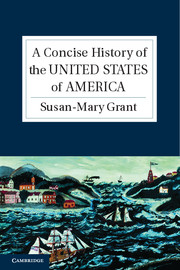Book contents
- Frontmatter
- Contents
- Figures
- Tables
- Acknowledgments
- Introduction
- 1 New Found Land
- 2 A City on a Hill
- 3 The Cause of All Mankind
- 4 Self-Evident Truths
- 5 The Last, Best Hope of Earth
- 6 Westward the Course of Empire
- 7 A Promised Land
- 8 The Soldier's Faith
- 9 Beyond the Last Frontier
- 10 A Land in Transition
- 11 Armies of the Night
- Notes
- Guide to Further Reading
- Biographies
- Index
2 - A City on a Hill
The Origins of a Redeemer Nation
Published online by Cambridge University Press: 05 June 2012
- Frontmatter
- Contents
- Figures
- Tables
- Acknowledgments
- Introduction
- 1 New Found Land
- 2 A City on a Hill
- 3 The Cause of All Mankind
- 4 Self-Evident Truths
- 5 The Last, Best Hope of Earth
- 6 Westward the Course of Empire
- 7 A Promised Land
- 8 The Soldier's Faith
- 9 Beyond the Last Frontier
- 10 A Land in Transition
- 11 Armies of the Night
- Notes
- Guide to Further Reading
- Biographies
- Index
Summary
For we must consider that we shall be as a city upon a hill. The eyes of all people are upon us. So that if we shall deal falsely with our God in this work we have undertaken, and so cause Him to withdraw His present help from us, we shall be made a story and a by-word through the world.
(John Winthrop, “A Model of Christian Charity,” 1630)The arrival of English women in Virginia in 1619 was designed to ensure the long-term stability of the settlement, to make it resemble more closely the world from which the English settlers, at least, had come. However, the introduction of African labor, which in time became the enslaved labor that would form the economic bedrock of the free-born English colonies, ensured that the society constructed in the New World would bear little resemblance to the world that the English and the Africans had left behind. Although one group arrived voluntarily and the other was coerced, both faced the challenge of constructing a new life in a new world. The arrival of the first Africans, too, highlighted the fact that the North American colonies were part of an emerging economic and social Atlantic world. So, too, was England, of course, but as the end-producer of the most obvious comestible commodities the New World had to offer – sugar, tobacco, cocoa – the actual processes, and personal costs of production were not as evident in the English communities from which Virginia's settlers came as they would be in the Americas.
The very existence of the Virginia Company signaled the rise of the new capitalist forces at work in this period, and in particular the emergence of a powerful merchant class that recognized the opportunities offered by the New World and had the ability to raise the venture capital that America's early “adventurers” had lacked. As the Virginia Company discovered, however, raising the money was perhaps easier than controlling the men in whose hands its investments lay. A broader range and higher rates of productivity were necessary to drive this early capitalist revolution, but productivity was notably lacking in the early Chesapeake with the exception of one crop – tobacco.
- Type
- Chapter
- Information
- A Concise History of the United States of America , pp. 39 - 70Publisher: Cambridge University PressPrint publication year: 2012

